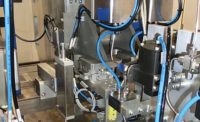Simplifying integration of peripheral devices
MotionWorks will be able to work with HMIs from several widely used vendors.

The latest version of the MotionWorks IEC programming environment will allow Yaskawa controllers to import and export files from HMIs and other peripherals from third-party suppliers. Photo courtesy Yaskawa America Inc.
When designing a complex machine, engineers have two options. They can get all parts of the system—controller, drives, motors, I/O and human-machine interface (HMI)—from a single vendor. Or, they can pick and choose devices from multiple suppliers.
Each strategy has benefits and limitations. The former has the benefit of convenience. Setting up peripheral devices, like the I/O and HMI, is easier within a common platform. On the other hand, the supplier may not offer a complete range of peripherals.
“Some controller manufacturers may get into the peripheral device market, but at the end of the day, it’s not really their game,” says Jacky Wong, product engineering and marketing manager at Yaskawa America Inc.
Selecting devices from multiple vendors gives engineers more options in terms of cost-savings, better functionality or brand preference. However, getting devices from multiple vendors to talk to each other can be challenging. Engineers often need to write their own programs to be able to import and export tag files from HMIs and other devices.
“Engineers could spend five to 10 hours trying to set up these devices,” says Wong.
Now, Yaskawa gives engineers the ability to choose either option. In November 2012, the company acquired VIPA Corp., a German manufacturer of PLCs, I/O modules and HMIs. The aim of the acquisition was to give engineers the option of using Yaskawa-branded HMIs and other peripherals in their machines. In addition, later this year, Yaskawa’s MotionWorks IEC programming environment will enable the company’s controllers to import and export files from HMIs and other peripherals from third-party suppliers.
“There will be no separate software. When engineers open up MotionWorks, the capability will be built within it,” says Wong.
MotionWorks will be able to work with HMIs from a selection of widely used vendors. Engineers would select which HMI they’re working with. Based on that selection, the software would then be able to recognize the files exported by the device, and to export a file that can be recognized by the HMI.
“With this tagging capability, all the hours of programming needed to communicate with an HMI are accomplished with the touch of a button,” says Wong.
An IEC61131-3 programming environment, MotionWorks IEC enables programmers to take advantage of several standard programming languages within one development package. These languages work predictably and seamlessly with one another.
MotionWorks IEC is available in two versions: Express and Professional. The Express version offers three languages: ladder logic (for digital sensory data representation), structured text (for assignment of mathematical algorithms), and function block diagrams (for machine control).
The Professional version offers two additional languages: sequential function chart and instruction list. Sequential function chart allows the programmer to graphically create program organization in terms of steps, actions and transitions. Active steps are indicated in red, which simplifies troubleshooting of complex operations. Instruction list is designed for PLCs. It is a low-level language that resembles assembly.
Programming codes are reusable across different Yaskawa IEC controller hardware. Variables and outputs can be referenced between different programming organization units.
“One of the most appealing aspects of our controllers is the different applications we have worked on,” says Wong. “We have developed numerous function blocks—which we call toolboxes—that can be downloaded for free. It’s like having a Yaskawa engineer write part of your code for you.”
Function blocks act like subroutines in regular text programming. Function blocks are graphical. Inputs are on the left side of the block; outputs are on the right. Function blocks are encapsulated. Variables go in, and variables come out. The code that’s inside never has to change, so engineers can reuse them over and over again. Dozens of function blocks are available for actions such as electronic camming and kinematic mechanisms
Looking for a reprint of this article?
From high-res PDFs to custom plaques, order your copy today!




